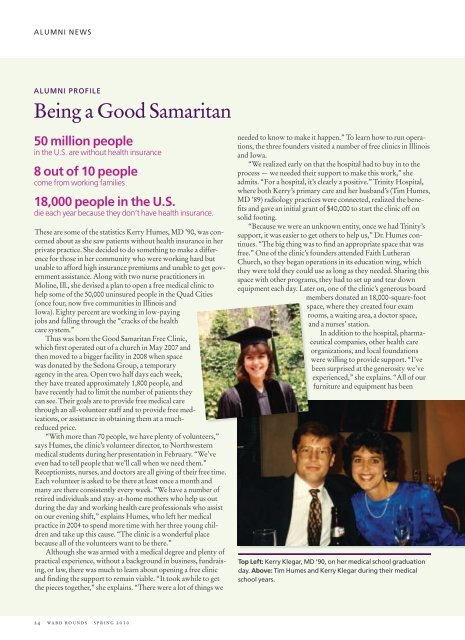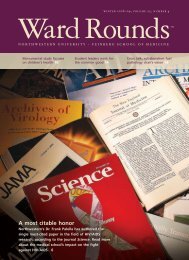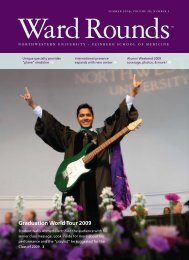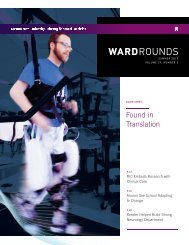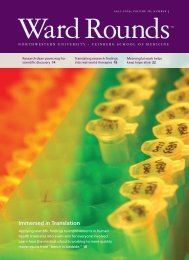Download PDF - Ward Rounds - Northwestern University
Download PDF - Ward Rounds - Northwestern University
Download PDF - Ward Rounds - Northwestern University
You also want an ePaper? Increase the reach of your titles
YUMPU automatically turns print PDFs into web optimized ePapers that Google loves.
ALUMni nEWS<br />
ALUMni proFILE<br />
Being a Good Samaritan<br />
50 million people<br />
in the U.S. are without health insurance<br />
8 out of 10 people<br />
come from working families<br />
18,000 people in the U.S.<br />
die each year because they don’t have health insurance.<br />
These are some of the statistics Kerry Humes, MD ’90, was concerned<br />
about as she saw patients without health insurance in her<br />
private practice. She decided to do something to make a difference<br />
for those in her community who were working hard but<br />
unable to afford high insurance premiums and unable to get government<br />
assistance. Along with two nurse practitioners in<br />
Moline, Ill., she devised a plan to open a free medical clinic to<br />
help some of the 50,000 uninsured people in the Quad Cities<br />
(once four, now five communities in Illinois and<br />
Iowa). Eighty percent are working in low-paying<br />
jobs and falling through the “cracks of the health<br />
care system.”<br />
Thus was born the Good Samaritan Free Clinic,<br />
which first operated out of a church in May 2007 and<br />
then moved to a bigger facility in 2008 when space<br />
was donated by the Sedona Group, a temporary<br />
agency in the area. Open two half days each week,<br />
they have treated approximately 1,800 people, and<br />
have recently had to limit the number of patients they<br />
can see. Their goals are to provide free medical care<br />
through an all-volunteer staff and to provide free medications,<br />
or assistance in obtaining them at a muchreduced<br />
price.<br />
“With more than 70 people, we have plenty of volunteers,”<br />
says Humes, the clinic’s volunteer director, to <strong>Northwestern</strong><br />
medical students during her presentation in February. “We’ve<br />
even had to tell people that we’ll call when we need them.”<br />
Receptionists, nurses, and doctors are all giving of their free time.<br />
Each volunteer is asked to be there at least once a month and<br />
many are there consistently every week. “We have a number of<br />
retired individuals and stay-at-home mothers who help us out<br />
during the day and working health care professionals who assist<br />
on our evening shift,” explains Humes, who left her medical<br />
practice in 2004 to spend more time with her three young children<br />
and take up this cause. “The clinic is a wonderful place<br />
because all of the volunteers want to be there.”<br />
Although she was armed with a medical degree and plenty of<br />
practical experience, without a background in business, fundraising,<br />
or law, there was much to learn about opening a free clinic<br />
and finding the support to remain viable. “It took awhile to get<br />
the pieces together,” she explains. “There were a lot of things we<br />
needed to know to make it happen.” To learn how to run operations,<br />
the three founders visited a number of free clinics in Illinois<br />
and Iowa.<br />
“We realized early on that the hospital had to buy in to the<br />
process — we needed their support to make this work,” she<br />
admits. “For a hospital, it’s clearly a positive.” Trinity Hospital,<br />
where both Kerry’s primary care and her husband’s (Tim Humes,<br />
MD ’89) radiology practices were connected, realized the benefits<br />
and gave an initial grant of $40,000 to start the clinic off on<br />
solid footing.<br />
“Because we were an unknown entity, once we had Trinity’s<br />
support, it was easier to get others to help us,” Dr. Humes continues.<br />
“The big thing was to find an appropriate space that was<br />
free.” One of the clinic’s founders attended Faith Lutheran<br />
Church, so they began operations in its education wing, which<br />
they were told they could use as long as they needed. Sharing this<br />
space with other programs, they had to set up and tear down<br />
equipment each day. Later on, one of the clinic’s generous board<br />
members donated an 18,000-square-foot<br />
space, where they created four exam<br />
rooms, a waiting area, a doctor space,<br />
and a nurses’ station.<br />
In addition to the hospital, pharmaceutical<br />
companies, other health care<br />
organizations, and local foundations<br />
were willing to provide support. “I’ve<br />
been surprised at the generosity we’ve<br />
experienced,” she explains. “All of our<br />
furniture and equipment has been<br />
Top Left: Kerry Klegar, MD ’90, on her medical school graduation<br />
day. Above: Tim Humes and Kerry Klegar during their medical<br />
school years.<br />
24 ward rounds spring 2010


